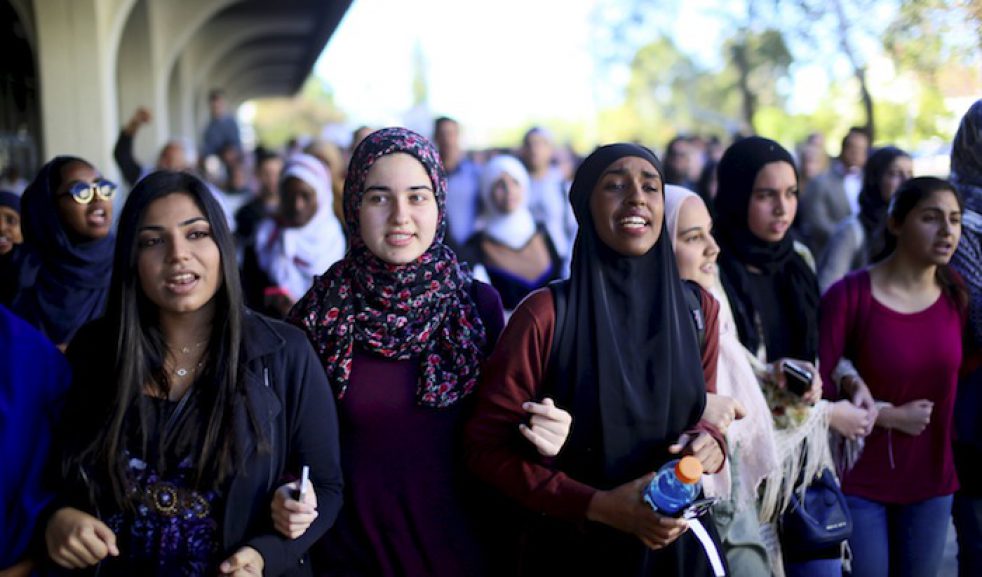Preface
Inspired by the #FergusonSyllabus, the #StandingRockSyllabus, the #BlackIslamSyllabus and others, this reading list provides resources for teaching and learning about anti-Muslim racism in the United States. Although “Islamophobia” is the term most recognizable in public discourse, it does not accurately convey the making of racial and religious “others” that fuels the forms of discrimination Muslims face in the United States. The term Islamophobia frames these forms of discrimination and their roots solely as a problem of religious discrimination. Calling this a “phobia” suggests that this discrimination is solely a problem of individual bias, which obscures the structural and systemic production of anti-Muslim racism.
This syllabus reframes “Islamophobia” as “anti-Muslim racism” to more accurately reflect the intersection of race and religion as a reality of structural inequality and violence rooted in the longer history of US (and European) empire building. Conceptually, a focus on anti-Muslim racism is connected to an analysis of history and forms of dominance – from white supremacy, slavery and settler colonialism, to multiculturalism and the security logics of war and imperialism – that produce various forms of racial exclusion as well as incorporation into racist structures. Our primary focus is on the manifestation and impact of anti-Muslim racism in the United States. At the same time, this syllabus insists on thinking about anti-Muslim racism as a global project that overlaps and intersects with the exclusion of other marginalized groups (e.g. Black, queer, Latinx, immigrant, indigenous, etc). It also connects the histories of various racial logics that reinforce one another, including anti-Muslim racism, anti-Black racism, anti-Latinx racism, anti-Arab racism, and anti-South Asian racism.
By focusing on understanding Islamophobia as anti-Muslim racism, this syllabus challenges the idea that the problem is one of individual bias and that simply knowing more about Islam will necessarily lead to a decrease in anti-Muslim racism. Instead, it suggests that learning more about how structures of violence, inequality, and war have produced anti-Muslim racism and discrimination and its wide-ranging impact on everyday life is essential in order to challenge its assumptions, logics, and practices. While the readings include pieces that address recent events like the 2017 “Muslim ban” executive order, they also show that similar policies extend to both earlier moments and other communities.
This is an interdisciplinary syllabus with social justice education as its objective. It is not meant to be an exhaustive or comprehensive list of resources or readings, but instead provides one possible curated list of teachable texts and materials that provide a good introduction to each section.
Goals of Syllabus:
- Define anti-Muslim racism as an alternative to the concept of Islamophobia
- Understand the relationship of race and religion to white supremacy through the racialized figure of the Muslim
- Provide an intersectional and comparative analysis to anti-Muslim racism
- Strategize ways to challenge anti-Muslim racism and resist white supremacy
The syllabus is organized by the following themes and topics, which move from broader framing issues to more specific examples. Later readings may benefit from the contextualization provided by earlier sections.
I. Race, Empire and Islam
II. The Production and Reproduction of Anti-Muslim Racism
III. The Impact of Anti-Muslim Racism
IV. Policing, Security and Anti-Muslim Racism
V. Resisting Anti-Muslim Racism
VI. Further Reading and Resources
This syllabus was built by Su’ad Abdul Khabeer, Arshad Ali, Evelyn Alsultany, Sohail Daulatzai, Lara Deeb, Carol Fadda, Zareena Grewal, Juliane Hammer, Nadine Naber, and Junaid Rana.
Thank you to Catherine Besteman, Louise Cainkar, Edward Curtis IV, Maryam Kashani, Zayn Kassam, Sherene Razack, Ihsan Sarfraz, Stephen Sheehi, Audra Simpson, Najeeba Syeed, Jessica Winegar for their contributions and feedback.
Image credit: Students chant while marching at a rally against Islamophobia at San Diego State University in San Diego, California November 23, 2015. REUTERS/SandyHuffaker
For comments please contact: IslamophobiaIsRacism@gmail.com
Download a pdf of the syllabus here.
PLEASE SHARE WIDELY.
Key Terms:
- Anti-Muslim Racism
- Capitalism
- Colonialism
- Countering Violent Extremism (CVE)
- Empire
- Gender violence
- Gender
- Homonationalism
- Islamophobia
- Militarism
- National Security Entry-Exit Registration System (NSEERS)
- Orientalism
- Patriot Act
- Pinkwashing
- Racialization
- Racism
- Security (National, Homeland, State…)
- Structural Inequality
- War on Terror
- White Supremacy
Contents:
- Orientalism
- The Long History of Anti-Muslim Racism
- Race and Racialization
- Anti-Black Racism and Anti-Muslim Racism in the US
- Anti-Muslim Racism as part of the “War on Terror” and US empire building
II. The Production and Reproduction of Anti-Muslim Racism
- The Islamophobia Industry, Funding, Government Policies, and the State
- The Media and Anti-Muslim Racism
- How Feminism contributes to Anti-Muslim Racism
- How Homonationalism and Pinkwashing contribute to Anti-Muslim Racism
- Christian Theology and Anti-Muslim Racism
- How Right Wing Zionism contributes to Anti-Muslim Racism
- How panic around refugees contributes to Anti-Muslim Racism
III. The Impact of Anti-Muslim Racism
- General Impact
- Shari’a Law Panics
- “Ground Zero Mosque”
IV. Policing, Security, Surveillance, and Anti-Muslim Racism
- Policing and Prisons
- Calls for Registration, NSEERS, and 2017 “Muslim Ban” Executive Orders
- Countering Violent Extremism
- FBI and Law Enforcement Surveillance
- Individual cases that highlight a range of issues
V. Resisting Anti-Muslim Racism
- Essays
- Comedy, Poetry, and Hip Hop
- Connections to Palestine
- Additional resources for resisting anti-Muslim racism
VI. Further Reading and Resources
